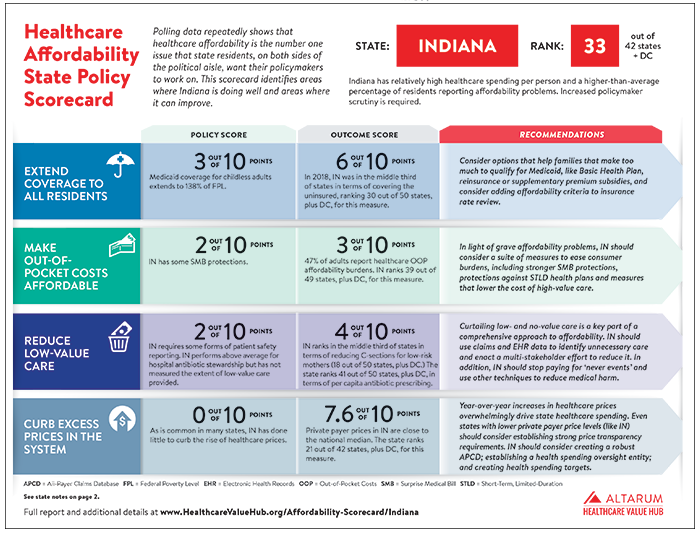State News
Indiana
Below is a list of healthcare value news from Indiana.
Indiana ranked 33 out of 47 states plus DC, with a score of 27.7 out of 80 possible points in the Hub's 2021 Healthcare Affordability State Policy Scorecard.
Report Finds Racial and Ethnic Disparities Persist in Indiana’s Health Care System
A report shows that racial and ethnic disparities in health care access, quality, and outcomes
persist in Indiana, reports WFYI Indianapolis. According to The Commonwealth Fund 2024
State Health Disparities Report, white people in Indiana experienced the highest health system
performance, while Black people experienced the lowest health system performance in the
state. In addition, Indiana ranked 28th of 47 states in health systems performance for Hispanic
people
Indiana Requires Notification for Health Care Mergers
Indiana will require health care entities to notify the state of mergers and acquisitions effective
July 1, 2024, according to the National Law Review. Health care entities with total assets of at
least $10 million dollars must provide notice at least 90 days prior to the merger or acquisition,
including written notice to the office of the Attorney General (AG). The AG will then review the
information and analyze in writing any antitrust concerns with the transaction. The change
comes following recommendations by the state’s Health Care Oversight Task Force, which
highlighted the role market consolidation plays in driving up health care costs. Notably, the
dollar threshold is lower than other states with similar statutes and applies to a wider range of
health care entities, including private equity firms.
Indiana Passes Law Monitoring Health Care Prices
Indiana has passed multiple laws aimed at monitoring the growth of private health care prices reports Fox 59. House Act 1004 requires a third-party contractor to review the prices non-profit hospitals are charging, compared to 285 percent of the Medicare reimbursement rate. In addition, Senate Act 8 requires pharmacy benefit managers, who are responsible for negotiating drug prices with manufacturers, to pass on at least 85 percent of their cost savings from rebates and discounts on to consumers.
Indiana Has Seventh Highest Hospital Costs of All States
The 2022 RAND 4.0 study found that Indiana has the seventh highest hospital costs, relative to Medicare prices, of all states measured, according to WFYI Indianapolis. Around the time of the study, Indiana legislators issued a letter to healthcare providers and insurers stating they would likely take steps to reduce healthcare costs in the next session if the providers and insurers do not make efforts to do so.
Indiana Unveils Hospital Cost and Quality Comparison Tool at Conference
Indiana hosted a National Hospital Price Transparency Conference discussing the state’s high hospital costs, where researchers discussed the impacts of consolidation and monopolies’ ability to increase prices, according to Wane 15. During the conference, the Employers’ Forum of Indiana unveiled a new dashboard to score healthcare systems on price and quality, which showed that Indiana has the seventh highest costs in the nation, relative to Medicare, without necessarily providing higher quality care. These tools are intended to help healthcare purchasers, such as private insurers, more aggressively negotiate rates with hospitals.
Indiana Will Study Health Inequities Following Death of Dr. Susan Moore
Following the highly publicized death of a Black doctor named Susan Moore, who alleged racist treatment at a hospital before dying of COVID-19, Indiana’s five major hospital systems are collaborating to create a dashboard tracking racial disparities in patient care, according to the Indy Star. The dashboard currently includes data on diabetes care and will later expand to infant mortality and mental health, although it is unclear when the dashboard will be available to the public.
Indiana Hospitals Among Most Expensive in the Country
Indiana's nonprofit hospitals are charging prices well above the national average and producing profit margins far above other states, according to a Wall Street Journal editorial. Indiana University Health and other large nonprofit hospitals in particular are charging far above the national average, while small, independent and rural hospitals are charging below the national average. State legislators have called for Indiana hospitals and insurers to present a plan that will reduce hospital prices to the national average within three years, otherwise they will pursue legislation to reduce prices.
Indiana’s Medicaid Expansion Panned in Federal Report
A federally commissioned study found that Indiana’s Medicaid expansion program had mixed results in improving health and access to care, reported Kaiser Health News. Indiana’s Medicare expansion program, called the Healthy Indiana Plan, requires eligible beneficiaries to make monthly contributions to a health savings account that is then used to pay for covered healthcare services. A federally funded study found that although the program increased healthcare coverage, it did not improve healthcare access, affordability or health status compared to both states that did and did not expand Medicaid.
Federal Government Extends Indiana's Medicaid Expansion Alternative for 10 Years
Indiana became the first state to receive a 10-year extension from the federal government for its alternative to traditional Medicaid expansion, the Healthy Indiana Plan, reports the Indianapolis Star. The plan provides benefits while at the same time requires beneficiaries to contribute in order to participate. Typically, states only receive a 2- or 3-year extension of their Medicaid expansion alternative health plan. The Healthy Indiana Plan currently insures more than 572,000 low-income Indiana residents, which is 100,000 more people than this time last year. The 10-year extension provides funding security for the next decade, while maintaining flexibility for Indiana to request federal approval to make improvements to the program down the line.
Indiana Among States Leading the Way in Responding to COVID-19
Indiana passed legislation requiring healthcare providers to give a “good faith” cost estimate to consumers five days before they deliver care, according to a Health Affairs blog that looked at how states are responding to the COVID crisis. The law also requires out-of-network providers delivering services in facilities that participate in health plan networks to accept the in-network negotiated rate unless consumers sign a statement consenting to the out-of-network charge.
For Smokers Trying to Quit, Chantix, Zyban Will No Longer Require A Prescription
The Indiana State Health Commissioner and Family and Social Services Administration Secretary announced that Indiana would join 11 other states in covering tobacco cessation prescription drugs, such as Chantix and Zyban, free of charge. According to IndyStar, studies place Indiana in the top 10 states with the highest smoking rates. About 22 percent of Indiana residents smoke and 13 percent of expectant mothers. In an effort to encourage expecting and new mothers to quit smoking, state officials announced mothers on Medicaid will no longer have a co-pay for tobacco cessation products for up to a year after a child’s birth.
Indiana's Religious Left Flexes Its Political Muscle
The religious right in Indiana has long been a powerful political force. But now a progressive interfaith movement, called Faith In Indiana, is trying to challenge that foothold, according to WBUR News. The group, consisting of a broad political spectrum of Muslims, Jews and Christians, has organized in minority communities on issues like immigration, universal health care, criminal justice reform, and early childhood education. Indiana's branch of Faith In Action launched statewide this year. It targeted five races in the general election, with the ambitious goal of ending the Republican supermajority in the statehouse.
Indiana Hospital Prices for Outpatient Care 'Shockingly High', RAND Report Says
According to the Indianapolis Star, a new Rand Corporation report finds the price Indiana hospitals charge for outpatient services “shockingly high,” more than three times what they charge Medicare for the same procedures. All of the charges are calculated relative to how much Medicare pays for the same services.
Experiment May Reveal Obamacare’s Future
Indiana’s Medicaid Healthy Indiana Plan (HIP) may become a model for other state Medicaid reform efforts, according to The Atlantic. The program includes two levels of coverage.HIP Basic is available to all Hoosiers with incomes below poverty, but excludes dental and vision coverage and includes steep copays, which can saddle low-income families with high costs.HIP Plus coverage -- available to people below 138 percent of poverty -- requires enrollees to make monthly premium payments amounting to 2 percent of the beneficiary’s income. Failure to pay the monthly premium results in the removal of HIP Plus coverage and prevents the beneficiary from re-applying for six months. Seema Verma -- HIP’s primary architect -- has been appointed head of the Centers for Medicare and Medicaid Services (CMS) by President-Elect Trump.
Heroin, Opioid Epidemic Has Not Gone Away
A new report from the Richard M. Fairbanks School of Public Health reveals the cost of the opioid epidemic, in human, fiscal, and collateral terms. Indiana has seen a large increase in the number of overdose deaths and babies born dependent on drugs their mother took during pregnancy. The report concludes that opioid-related issues are putting a strain on police departments, other government services, employers and taxpayers. It cites the sharp increase in emergency care, which imposes a large financial cost and harms a hospital’s ability to deliver timely care. The report recommends a focus on prevention, including better information-sharing among health care providers.
In Conservative Indiana, Medicaid Expansion Makes Poorest Pay
The Washington Post reports Indiana’s approach to Medicaid With Healthy Indiana, enrollees can choose basic coverage that requires no monthly fee but excludes dental and vision. Or they can pay a monthly fee for enhanced coverage with those benefits. What is not clear is whether Healthy Indiana is paying off for the state and worth modeling in others.
Indiana Credits Higher Reimbursement For Medicaid Provider Growth
Indiana has added 939 providers, including 335 physicians, to the networks of the Healthy Indiana Plan and other Medicaid programs since the Centers for Medicare and Medicaid Services approved the state's alternative Medicaid expansion plan in January 2015. The Healthy Indiana Plan reimburses providers at Medicare rates, and the state raised reimbursements on average by 25 percent for those treating the traditional Medicaid population. More information here.
Indiana’s Medicaid Expansion Waiver Proposal Needs Significant Revision
The Center on Budget and Policy Priorities reported that a 2012 Mathematica evaluation of Indiana’s existing HIP waiver showed that the required POWER account contributions (that is, the premiums under HIP) effectively restrict HIP enrollment. The evaluation found that over a five-year period from 2008 to 2012, some 17 percent of those found eligible for the program — or over 21,000 people — never enrolled because they didn’t pay the initial premium. Moreover, at the time of the evaluation, HIP covered people with incomes up to 200 percent of the poverty line, but 69 percent of those who didn’t enroll because of non-payment of the initial premium had incomes below 100 percent of the poverty line. And of those who did enroll, 12 percent subsequently lost coverage because they failed to pay premiums, with 58 percent of those being people with incomes below the poverty line.
Healthy Indiana Plan Demonstration, Section 1115 Annual Report
In the Healthy Indiana Plan Demonstration Section 1115 Annual Report, an evaluation of the predecessor program found that the program attracted many consumers with chronic disease as they had no other insurance option. While many were able to make their contributions to the POWER accounts, 14 percent of former HIP members reported that cost-sharing was their reason for leaving the program.







